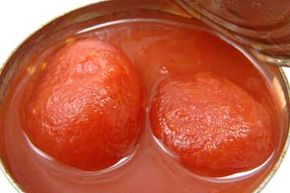If a recipe calls for a couple of peeled tomatoes, you might consider peeling fresh ones yourself by tossing them in a pan of boiling water for a few seconds. But if you consider the manpower it would take to line ever grocery store in the world with shelves containing skinless tomato products, well, you begin to realize there has to be a more efficient way.
Enter flash steaming. Flash steaming uses basically the same process you would at home, but on an industrial scale. And instead of using a pot of boiling water, flash steaming involves steam, as the name implies, to make the magic happen. The process is pretty simple. Typically, a batch of tomatoes is fed into a pressurized metal chamber that's rotating slowly. Hot steam is shot into the chamber, where it heats up the surfaces of the tomatoes but leaves the interiors uncooked. The moisture underneath the skin of the tomato is vaporized by the heat, and it loosens and peels away. After just a few seconds, the steam stops and is sucked back out. Then the product is cooled, often with jets of water that also help clear off any remainders of peel. And it all happens in a flash, as it were.
Advertisement
Flash steaming is a step along the production line for all sorts of foods. Tomatoes can be found on lots of ingredient lists, after all, and most of the time they don't get there with their peels still on. Tomato juice, salsa, pizza sauce and ketchup are good examples, to name just a few.
When it comes to pulling the peels off an assortment of fruits and veggies, there are other methods that can also be used, like lye peeling, flame peeling, knife peeling and abrasion peeling. Different foods work best with different techniques, although some can be processed by more than one means. For example, lye peeling is also sometimes used in tomato processing.
To find out how fast a flash steaming machine can work -- and more about all those tomatoes popping out of their peels -- continue on to the next page.
Advertisement



